Working at Heights for construction workplaces has been around for just over 3 years now. The Ministry of Labour (MOL) has made it very clear in the past that it would implement a similar strategy for businesses that fall under the industrial establishment regulations. This would have meant that in order to achieve compliance, an industrial establishment would have had to receive training from a Chief Prevention Office (CPO) approved training provider like Industrial Safety Trainers. There would have been new training standards that would ensure all training programs met strict guidelines.
The Ministry of Labour released a proposal a few months ago that addressed upcoming changes to those that may be working at heights within the industrial sector. While the proposal indicated changes similar to the current standards for construction companies with regards to the different kinds of fall protection, they did not propose changes to the current training requirements. Currently, Regulation 851 for Industrial Establishments states that:
“Section 79. A worker required to wear or use any protective clothing, equipment or device shall be instructed and trained in its care and use before wearing or using the protective clothing, equipment or device”
This could be interpreted as companies only needing to train their workers to wear a harness and to know how to inspect one when it comes to working at heights. The Ministry of Labour did not seem keen to define exactly the training parameters needed to train workers effectively in this scenario.
The proposal also addressed the need for businesses to conduct risk assessments for work that could be considered ‘high risk’. What the MOL is asking businesses to do is:
- Conduct a risk assessment of jobs that have associated safety risks.
- Once the risks have been identified, and this would include working at heights risks (ladders, scissor lifts, cages, scaffolds, etc.), develop some means of control to protect your workers. The risk assessment controls matrix determines that you should first try to eliminate the risk, and if you can’t, minimize it by implementing safe work instructions or the use of personal protective equipment such as safety harnesses and lanyards.
- Train workers on the hazards associated with the work they are tasked. This training may include the proper use of any personal protective equipment (PPE).
What is the future of Working at Heights for the Industrial Sector?

For now, it appears that businesses will need to create risk assessments that are documented and shared with the company’s Joint Health & Safety Committee. Risk assessments will lead to writing safe work instructions, allowing your workers to know the clear guidelines your company wants to uphold in order to minimize hazardous conditions. These safe work instructions will have to include working at heights as well. For example, if the work involves using ladders, you would have to include elements on the proper use of said ladder. Not only would the instructions be about the basic rules of ladder safety, but also what exact ladder is to be used and how to set it up properly. If your company were to use equipment such as scissor lifts or working on scaffolds, your safe work instructions would have to include the proper use of safety harnesses and lanyards. As with ladders, you would also provide specific instructions on what type of harness and lanyard workers need to use, and how to be tied off properly and to what anchor point.
We assume the Ministry of Labour decided to only propose these changes because of the difference in industrial and construction sectors. In construction projects, every day could be potentially different since they could be working in multiple sites with different conditions, different anchor points, etc. Workers in construction are taught to evaluate the work they will be conducting and the different ways they could protect themselves from a potential hazard. Industrial projects, however, have rules and processes in place which makes the work more consistent. Industrial businesses have the ability to determine where their workers could be at risk and be much more specific as to how workers can ensure their safety.
We believe the Ministry of Labour’s plan is to have companies train their own workers with their own tools and equipment. In a near future, you may choose not to use a company like Industrial Safety Trainers anymore for Fall Arrest/ Fall Protection training and instead use us for risk assessments and consulting. We will be able to help you with your risk assessment, teaching you how to create safe work instructions, and how to train your own workers properly. The actual training for working at heights for industrial establishments may have to fall on the company’s hands.
The MOL is definitely moving in the right direction when it comes to keeping workers safe who work at heights. We would strongly recommend that employers take a look at the proposed changes and model how they train their workers in the form of a comprehensive safe work instruction manual or with safety talks. These proposed changes, while they are not the law yet, will come in to effect eventually so it would be a good idea to get a head start and contact us to figure out what the next steps would be for you. We can help you with all your safety needs, simply call 1-800-219-8660 or send us a message!



